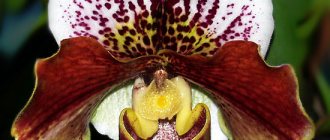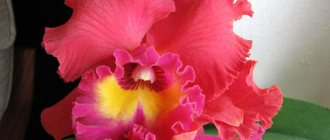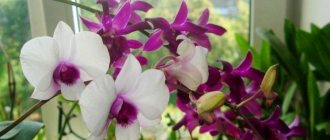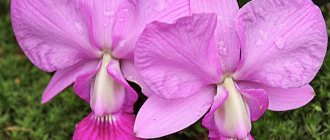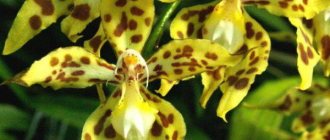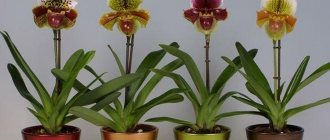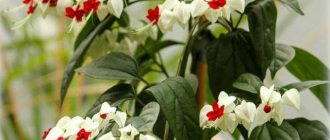Author: Elena N. https://floristics.info/ru/index.php?option=com_contact&view=contact&id=19 Category: Houseplants Published: January 03, 2019Last edits: January 11, 2021
- Care during flowering
- Apricot Paphiopedilum (Paphiopedilum armeniacum)
Paphiopedilum orchid (lat. Paphiopedilum), or paphiopedilum, or Lady's slipper , is a genus of herbaceous perennial plants of the Orchidaceae family, growing in Kalimantan, Sumatra, the Philippines, New Guinea, Malaysia, China, Thailand, India and Nepal. The scientific name of the genus is derived from the toponym of the mythical homeland of the goddess Venus - Paphos and a word meaning “sandal” or “shoe”. That is, literally “paphiopedilum” is translated as “slipper from Paphos”: the flower of the plant is shaped like a woman’s slipper. The first Paphiopedilum orchid was discovered by Nathaniel Wallich in 1816, and in 1820 Paphiopedilum bloomed for the first time in cultivation - in the Liverpool Botanic Garden. By the beginning of the 21st century, about 70 species of this genus have been described, and some of them are popular indoor plants. In addition to species, many varietal orchids are also grown in culture, as well as natural and artificial hybrids of Paphiopedilum - grex.
origin of name
The name of the genus is formed on the basis of two words: from the name of the homeland of the goddess Venus from the city of Paphos in Cyprus and the word pedilon (shoe, sandal).
Literally Paphiopedilum translates as Paphos slipper or slipper of Paphos .
Ancient mythology tells that once while hunting, the goddess Venus and Adonis were suddenly caught in a thunderstorm. The loving couple took refuge in a cave, and Venus left her wet shoes at the entrance.
A random traveler passing by did not notice the goddess and her lover, but saw golden shoes on the ground. As soon as he bent down to pick them up, the latter turned into beautiful flowers.
Description history
At the end of the 19th century, the genus received independent status; before that, they all belonged to the genus Cypripedium.
The first representative of this genus to reach Europe was Paphiopedilum venustum , found in 1816 in northeastern India by the Danish botanist Nathaniel Wallich and described from a specimen that bloomed in 1819 in the Calcutta Botanical Garden.
Paphiopedilum venustum
A little later, in the same region, Wallich found another similar plant, Paphiopedilum insigne , which was sent to England and bloomed in the Liverpool Botanic Garden in the autumn of 1820 .
Paphiopedilum insigne
In 1836 Paphiopedilum purpuratum bloomed at the Loddigzo Royal Exotic Nursery in England (this species is found near Hong Kong, in the Chinese province of Guangdong and on Hainan Island).
Paphiopedilum purpuratum
At the beginning of the 21st century, about 70 species have been described. One of the recently discovered species of this genus, Paphiopedilum hiepii, was discovered in the jungles of Vietnam in the late 1990s and described by St. Petersburg scientist L.V. Averyanov.
The best types and varieties of paphiopedilum lady's slipper orchid
Paphiopedilum Delenatii
Paphiopedilum Delenatii photo
The plant is native to Vietnam. Leaf blades are 10 cm long, spotted. The flowering stem at the top is decorated with 1-2 large flowers (about 8 cm in diameter). The lower lip is bag-shaped, pale lilac in color. The sepals and petals are white, the center is yellow. The flowering period is from January to December.
Paphiopedilum Maudie Paphiopedilum Maudiae
Paphiopedilum Maudie Paphiopedilum Maudiae Femma photo
The hybrid was obtained in 1900 by the English botanist Joseph Charlesworthy. The leaf plates are oblong, about 10 cm long, decorated with a marble pattern (a combination of dark green and light green). The flower is single, the lower lip is greenish, and the petals and sepals are white-green and striped. The flowering period occurs at any time of the year. In Europe it is often used as a cut flower to create bouquets.
There are many Maudi hybrids, the most popular are:
Alba of a white-green shade, among them: Femma, Aitch, Charlotte, Clair de lune, Bankhaus, Magnificum, The Queen;
Paphiopedilum Maudiae Vinicolor photo
Vinicolor (the inflorescence is almost entirely burgundy): Black Jack, Black Cherry, Blood Clot, Red Fusion, Ruby Peacock;
Coloratum (inflorescences combine white-green-burgundy shades), most often found on sale in Los Osos.
Paphiopedilum Pinocchio Paphiopedilum Pinocchio
Paphiopedilum Pinocchio Paphiopedilum Pinocchio
A hybrid orchid with a sympodial type of growth, 35-40 cm high. The leaf blades are oblong, obovate, with rounded tops. Revolver flowering. The lower lip is brightly grown, in the form of a bag, covered with spots of a purple hue, the petals are oblong, wide open, the petals and sepals are covered with fluff.
Paphiopedilum Americanum Paphiopedilum Americanum
Paphiopedilum American Paphiopedilum Americanum photo
People call the orchid “cabbage head” because it is low, has a dense rosette of leaves, and consists of elongated juicy green leaves. There is a single flower on a short peduncle. The combination of white, yellow, brown and greenish shades in the inflorescence creates a harmonious composition.
Appleton's Paphiopedilum or Appleton Paphiopedilum appletonianum
Paphiopedilum Appletonianum Paphiopedilum appletonianum photo
An orchid with large inflorescences about 10 cm in diameter, fragrant flowers of a green-lilac hue. The flowering period is spring. The leaf blades are rigid, belt-shaped, with rounded tops, and have a marble pattern.
Paphiopedilum apricot Paphiopedilum armeniacum
Apricot Paphiopedilum Paphiopedilum armeniacum photo
The leaf blades are oblong, up to 15 cm long; a marble pattern of a lighter shade is spread out on a dark green background. The flower is large, sunny yellow, the core is decorated with a darker color.
Paphiopedilum barbatum
Bearded Paphiopedilum Paphiopedilum barbatum photo
It has been in cultivation for a long time; the first hybrid (Harrisianum) was bred on its basis. The length of the leaf plates is 20 cm, there is a marble pattern. Blooms in spring. The diameter of the flower reaches 8 cm, the lip is burgundy-green, the petals are darker, and the sepals are covered with linear stripes of burgundy color, with a snow-white border along the edge.
Paphiopedilum hirsutissimum
Paphiopedilum hirsutissimum photo
The name was obtained due to the highly pubescent peduncle. Another feature: at first the petals are smooth, widening at the ends, and after a while they become corrugated.
Paphiopedilum insigne
Paphiopedilum wonderful Paphiopedilum insigne variety Lady Slipper photo
It has linear green leaf blades, the length is 25-30 cm. It blooms in September, the flowering period lasts until February. Inflorescences are greenish in color.
Paphiopedilum villosum
Paphiopedilum villosum photo
Can be grown as an epiphytic plant (on a block of tree bark) or in a flower pot with a special substrate. Flowering occurs in the spring-autumn period. The peduncle is 30 cm long, pubescent, bears a single flower. The sepals are brown-green with a white border, the petals are brown-ocher, the shoe-shaped lip is a pale red-brown tone, covered with thin veins.
Paphiopedilum bellatulum or pretty Paphiopedilum bellatulum
Paphiopedilum pretty Paphiopedilum bellatulum photo
The orchid was first discovered in Burma in the 19th century and is also found in China and Thailand. It lives on mossy cliffs at an altitude of 250-1500 m above sea level. The leaves are oblong, spotted, 15 cm long. The flowering period is spring (starts in April). The flowering stem ends in 1-2 snow-white flowers, there are crimson specks, and the diameter of the flower is 10 cm.
Paphiopedilum lawrenceanum
Paphiopedilum lawrenceanum photo
A native of the island of Borneo. Spring flowering species. Peduncle with a single flower reaching a diameter of 15 cm. The “slipper” is brown-red, the petals are greenish with reddish spots, the sepals are striped, white-green. The leaf plates do not exceed 15 cm in length and are decorated with a light marble pattern. The species is relatively easy to cultivate.
Paphiopedilum niveum or snow-white Paphiopedilum niveum
Paphiopedilum niveum
The flowering period occurs in the summer months. The flowering stem is 15-20 cm long, at its top there are two snow-white fragrant flowers with a diameter of about 8 cm. The orchid requires warm keeping and needs feeding less than others.
Paphiopedilum beautiful or lovely Paphiopedilum venustum
Paphiopedilum beautiful or lovely Paphiopedilum venustum photo
Originally from the Himalayas. The flowering period starts at the end of winter. The length of the peduncle is 15-20 cm, at the top there is a single flower with a diameter of about 15 cm. The lip is helmet-shaped, glossy, bright orange in color and with green veins, the petals are greenish-orange in color, they contain large black dots and greenish veins.
Biological description
Escape of sympodial type.
The stem is short.
All species have a rhizome Usually very shortened, but there are exceptions (Paphiopedilum druryi, Paphiopedilum robinsonii and Paphiopedilum armeniacum).
The roots are well developed.
The leaves are broadly linear, belt-shaped or oblong, close together in a double-sided rosette, from 5 to 60 cm. In some species the leaves are single-colored, pure green, while in others they have a dark marble pattern.
Peduncles from 4 to 60 cm long. Most species have single-flowered inflorescences. Paphiopedilum victoria-regina can produce more than 30 flowers successively on one peduncle. Multiflowered species produce several flowers on a single peduncle. From 2-3, to 13 or more.
Paphiopedilum victoria-regina
The flowers are large and varied in color. The upper sepal (sail), often wide and brightly colored, is sometimes folded forward like a visor, which limits rainwater from entering the inner part of the lip and onto the reproductive parts of the flower.
Paphiopedilums bloom for 2–9 months . The aroma is weak and inconsistent, with notes of vanilla and apple.
Based on the type of flowering, they are divided into three groups:
- single-flowered - one bud on the peduncle;
- multiflora - the plant has several buds that open at the same time;
- revolving - a multi-flowered orchid, during the flowering of one bud it forms the next.
All members of the tribe Cypripedioideae have two fruiting anthers, while other tribes have only one. The third anther is sterile, modified into a thyroid body called the "staminode", which is located in front of the column at the base of the lip and covers the reproductive parts.
Paphiopedilum often confused with Cypripedium . Unlike , Paphiopedilum:
- short stem;
- in rosettes from 4 to 12 leaves 10–35 cm long;
- the shape can be belt-like or broad-linear;
- color in different shades of green, plain and with a marble pattern;
- leaves are arranged symmetrically;
- peduncles from 4 to 50 cm high, often single-flowered, but there are also several buds (2–13 or more).
Diseases and pests of Paphiopedilum
If the room has excessively high humidity and is quite cool, this may cause the development of a fungal disease on the Paphiopedilum orchid. The affected bush should be sprayed with a fungicide solution. At the same time, the plant must be provided with optimal conditions for growth, otherwise the problem will return again.
Pests such as mealybugs, scale insects and spider mites can settle on paphiopedilum. As a rule, scale insects and scale insects settle on the underside of the leaf plate. If pests are detected, they are removed from the plant with a cotton swab dipped in a solution of high concentration soap or alcohol. After this, the bush is thoroughly washed under a warm shower. However, if the measures taken turn out to be ineffective, then the orchid will need to be treated with an insecticidal agent.
Measures to combat spider mites are completely different. The fact is that they are so small in size that they are almost impossible to see with the naked eye. You can tell that mites have settled on a flower by pale yellow spots at the puncture sites, as well as by a thin cobweb on the foliage. If a pest is detected, wash the bush under a warm shower, wait until it dries well, and then spray it with a solution of Karbofos, Actellik or Fitoverm. Since these pesticides are very toxic, it is recommended to carry out the treatment in a well-ventilated area or outdoors.
Peculiarities
Only two species are epiphytes :
- Paphiopedilum parishii;
- Paphiopedilum lowii.
Paphiopedilum lowii
Three species of hemi-epiphytes (found growing on the ground and on trees):
- Paphiopedilum hirsutissimum;
- Paphiopedilum villosum;
- Paphiopedilum glanduliferum.
Paphiopedilum hirsutissimum
The remaining species are either terrestrial or lithophytes .
Conditions of detention
Temperature
Warm temperature orchids This includes virtually all spotted-leaved .
Summer : 20-25 °C; Winter : 16-22 °C.
2. Orchids of moderate temperature conditions. This includes Paphiopedilums with narrow green leaves .
Summer : during the day 20-22°C, at night 17-19°C; Winter : 20-23 °C during the day, 13-16 °C at night.
3. Orchids of moderate-warm temperature conditions. This includes almost all multicolored Paphiopedilums, i.e. “revolving” flowering orchids , when one flower fades and another appears on the same peduncle.
Summer : 20-23 °C; Winter : 18-22 °C.
4. Orchids of moderate temperature conditions. This includes Paphiopedilums with broad green leaves .
Summer : 18-25 °C; Winter : 16-20 °C.
It is advisable to ensure a difference between night and day temperatures of +3...+5 °C.
Lighting and location selection
Daylight hours are at least 12 hours .
Most species require bright, indirect light . This is a must for a multiflora group with monochromatic leaves .
Shade-tolerant and even shade-loving plants are orchids with marbled leaves .
Rest period
To stimulate flowering, Paphiopedilum with spotted leaves requires a clearly defined period of rest.
It starts in mid-November. The orchid is kept drier and colder than usual.
Night temperature during this period should be no more than +15 °C . Watering the orchid should be replaced with light spraying of the substrate.
After the appearance of flower stalks, the dormant period ends. Watering is resumed in the usual volume, and the temperature rises.
Failure to observe the rest period leads to not blooming .
Bloom
Paphiopedilums bloom once or twice a season , each species consistently at the same time.
The signal for flowering is a stop leaf in the center of a new rosette. It may turn out to be empty, but most often it produces a peduncle.
The height of flowering of the species Paphiopedilum occurs in autumn and spring , hybrids can bloom at any time of the year.
The duration of flowering in the general group varies from species to species and can range from 2 months to 2 years .
Paphiopedilums with one flower on a peduncle bloom for 2-4 months .
Paphiopedilums of “revolving” flowering, the flowers of which appear one after another on the same peduncle, bloom for 6-7 months , this includes Paphiopedilum glaucophyllum and Paphiopedilum primulinum.
Paphiopedilum Pinocchio
Paphiopedilum Pinocchio can bloom for up to 15 months , and Paphiopedilum chamberlainianum for up to 2 years.
Paphiopedilum chamberlainianum
After flowering
Actions after Paphiopedilum flowering directly depend on which subspecies the orchid belongs to.
1. In representatives of Paphiopedilum, in which there is only one flower the peduncle is removed after flowering , if necessary, the orchid is replanted and kept dry for some time. This is necessary to acclimatize the plant and to prevent rotting of wounds on the roots resulting from transplantation.
2. Representatives of “ revolving ” flowering do not prune until the end of flowering (up to 24 flowers appearing one after another on one peduncle):
- Paphiopedilum primulinum;
- Paphiopedilum glaucophyllum;
- Paphiopedilum Pinocchio;
- Paphiopedilum moquettinum;
- Paphiopedilum chamberlainianum.
Being outdoors
From June to the end of August, it is recommended to keep Paphiopedilum with green leaves outdoors: on the balcony or in the garden.
Choose a place protected from rain, strong winds and direct sunlight.
Watering, air humidity and fertilizing for paphiopedilum orchids
How to water
During the period of active growth of Paphiopedilum lady's slipper orchid, it needs abundant watering. Watering is reduced with the onset of flowering, and during the dormant period, watering is carried out after the substrate has completely dried. Resume intensive watering when new leaves and shoots begin to grow.
Neither overmoistening nor prolonged drought should be allowed. The higher the air temperature, the more often you water. If you notice a “mushroom” smell from the substrate, spray the soil with a fungicide and reduce watering.
For irrigation, use tap water that has been standing for at least 24 hours, or preferably rainwater, at room temperature. When watering, avoid getting drops of water on the leaf blades, as this may cause brown spots to appear on them. During the period of active growth, it is recommended to take a warm shower every two weeks, simulating tropical rain showers. Every week, wipe the leaf plates with a soft damp cloth to remove dust, which not only serves to maintain decorativeness, but will allow the leaves to “breathe” and protect against damage by spider mites.
Air humidity
An important care point is the level of air humidity. Follow the principle: the hotter it is, the higher it should be. Under normal conditions, 40-50% is sufficient, but in extreme heat (the air also becomes very dry during the operation of heating systems), an increase to 60-70% will be required. You cannot spray the plant, so use artificial air humidifiers; you can place an aquarium, an artificial fountain or a regular container of water nearby.
There is a way to create a humidifier yourself: place pebbles and expanded clay on a tray, place a pot with a plant there and periodically add water. Don’t forget to wash the pan monthly so that the “humidifier” does not become a breeding ground for diseases and pests (fungus gnats, etc.). The humidity level can be adjusted using sphagnum moss, which should be laid around the plant itself, without touching the root collar; spray the moss periodically.
When and how to feed
The plant reacts negatively to excess fertilizer; feed only during the period of active growth (during flowering and the dormant period, no need to feed). Apply special fertilizers for orchids every 2 weeks; regarding concentration, follow the manufacturer’s recommendations.
Home care
Transfer
Due to the high degree of sensitivity of the root system to substrate salinity, they require periodic replanting into fresh substrate.
On average , transplantation is carried out every 2 years .
Paphiopedilum should not be replanted according to a schedule, but taking into account :
- species-specific features of the orchid;
- quality of water used for irrigation (presence of impurities and their quantity);
- composition of the substrate and the degree of its decomposition, salinity;
- composition of fertilizers used and frequency of fertilizing, etc.
You should focus on your conditions of detention and the needs of a particular orchid.
replant at the end of winter - beginning of spring (this is the period of root activity) or immediately after the plant has finished flowering.
In cases of salinity or decomposition of the substrate, it is necessary to replant the plant without waiting for the planned replanting season.
A few days before transplantation (3-5), the plant is not watered so that the substrate is dry at the time of transplantation. It is easier to remove the plant from a dry substrate without damaging the root system.
Removing a plant from an old substrate is carried out by freeing its root system from the remnants of the substrate, carefully pulling it out of the planting container.
The transplant is carried out into a pot corresponding to the root system of the orchid, i.e. according to the size of the roots (the diameter of the container is equal to the previous one or 1-2 cm larger).
Planting is done by immersing the orchid in a pot and filling it with substrate so that the root system of the plant is closed, the base of the shoot is buried in the substrate (1-3 cm - depending on the size of the plant being transplanted), and the lower leaves are above the surface of the substrate.
Substrate : 4-5 parts bark + 2 parts chopped sphagnum moss + 1 part peat.
Place a layer of sphagnum moss on the surface of the substrate (this increases the humidity of the environment and promotes the formation and good growth of roots).
Watering
Throughout the year, Paphiopedilum needs frequent and abundant watering.
When watering, excess water flow freely from the pot, since stagnation of water both inside the pot and in its tray can very quickly lead to rotting of the roots and lower part of the orchid.
The substrate should dry well between waterings, but not dry out completely. Keeping Paphiopedilum completely dry for a long time (2 or more days) is not acceptable.
Planting and caring for paphiopedilum
- Flowering: first time - in the sixth or seventh year. Flowering can last up to six months.
- Lighting: twelve-hour daylight hours. Green-leaved and multi-flowered plants need bright, diffused light, while variegated and few-flowered plants are more comfortable in partial shade.
- Temperature: depending on the variety, in summer from 20 to 23 ºC, in winter – from 17 to 19 ºC. A difference of 3-4 degrees between day and night temperatures is required for any paphiopedilum.
- Watering: during the growing season - regularly, as soon as the top layer of the substrate dries, during the dormant period - only after the substrate has completely dried.
- Air humidity: increased: the warmer the air in the room, the higher its humidity should be.
- Feeding: during active growth - 2 times a month alternately with organic and mineral solutions in half the dosage. During the dormant period, fertilizing is not needed.
- Dormant period: not clearly defined, but after flowering the orchid should rest in cool conditions, without fertilizing and with minimal watering for at least one and a half months.
- Transplantation: in spring: young orchids - annually, adults - once every 2-3 years.
- Reproduction: by dividing the bush.
- Diseases: fungal infections, mainly rot.
- Pests: scale insects, spider mites, mealybugs.
Read more about growing paphiopedilum below.

